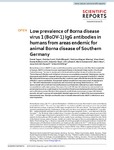Low prevalence of Borna disease virus 1 (BoDV-1) IgG antibodies in humans from areas endemic for animal Borna disease of Southern Germany
Tappe, Dennis
Frank, Christina
Offergeld, Ruth
Wagner-Wiening, Christiane
Stark, Klaus
Rubbenstroth, Dennis
Giese, Sebastian
Lattwein, Erik
Schwemmle, Martin
Schmidt-Chanasit, Jonas
Wilking, Hendrik
Borna disease virus-1 (BoDV-1) was recently discovered as cause of severe and often fatal encephalitis in humans. BoDV-1 is known to cause neurological disease in horses and sheep mainly in South and Central Germany. The virus is maintained in bicolored white-toothed shrews (Crocidura leucodon). The incidence of infection and risk factors in humans are completely unresolved. Veterinarians may be disproportionally BoDV-1-exposed through contact to animals not recognized to be BoDV-1 infected. We conducted three serosurveys predominantly in endemic areas of South Germany for the presence of BoDV-1-reactive antibodies. Anonymized residual samples from two serosurveys of veterinarians (n = 736) with interview data on exposures and one serosurvey among blood donors (n = 373) were screened with an indirect immunofluorescence antibody test, followed by a newly developed immunoblot as confirmatory assay. One serum from a 55–59-year-old veterinarian who worked in an animal practice and as a meat inspector but none from blood donors tested positive by the screening and confirmatory assays. We show that seropositive individuals are rare even in areas with highest zoonotic risk and in a group with potentially elevated exposure risk. In light of the low seroprevalence demonstrated here, the high case-fatality rate in clinically observed human BoDV-1 infections is even more impressive.
Dateien zu dieser Publikation

